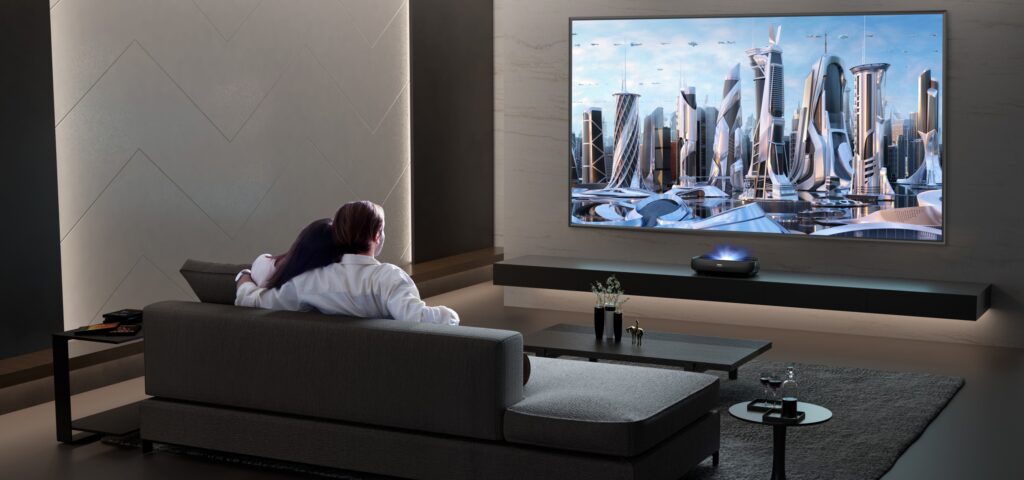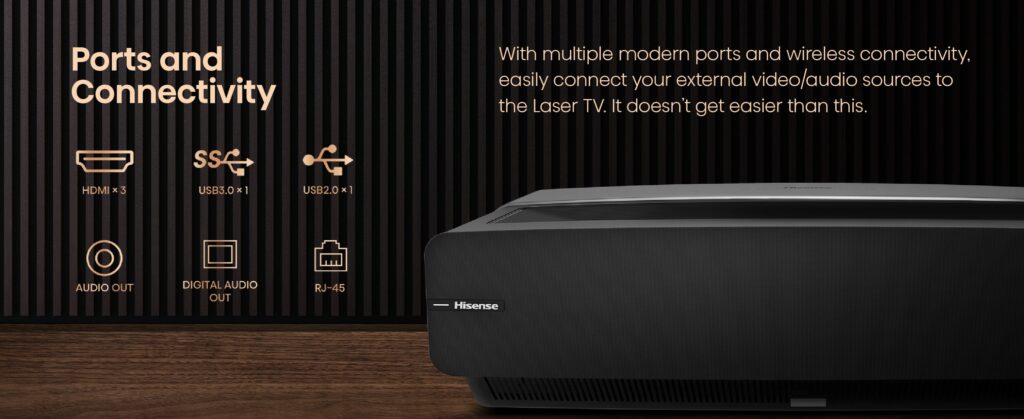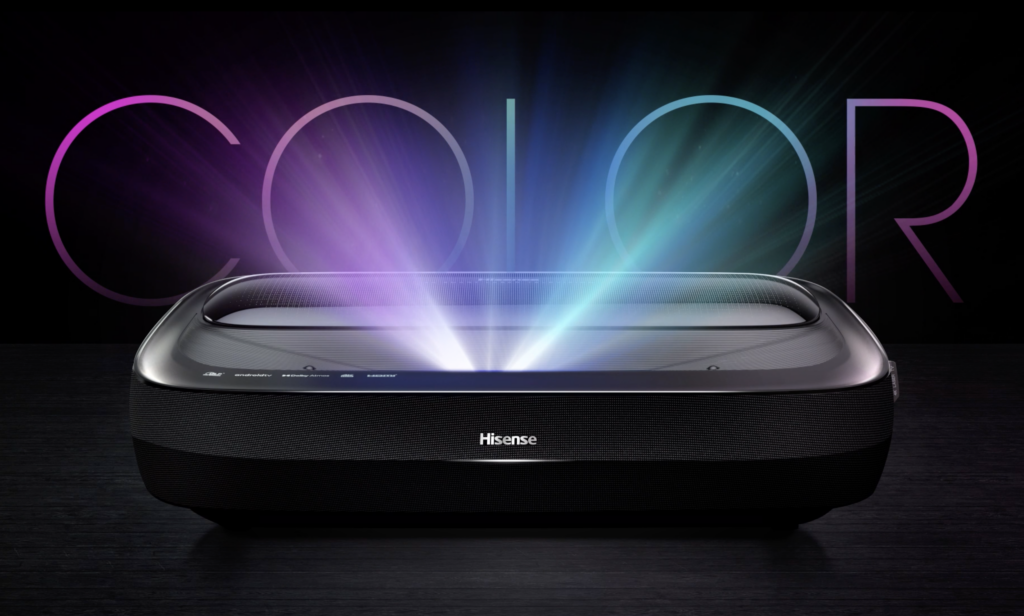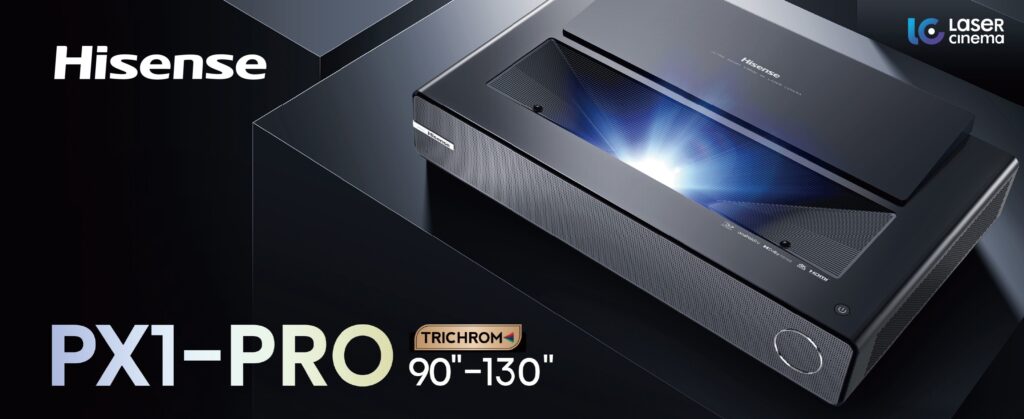
In the still nascent market of home laser televisions, Hisense has established itself as one of the early leaders in the field. While larger, more established electronics manufactures in the United States – the Sonys, LGs, Epsons, and the like – have dabbled in the field (and even put out some high-quality models) a few independent players have put themselves all-in on the new lazer TV trend – namely Hisense, BenQ, AWOL Vision, and Formovie.
Today we start with an overview of Hisense. Perhaps no company has made a bigger splash in the still young Laser TV market than Hisense. Hisense may not be familiar to many Americans, but in China, they are one of the largest conglomerate manufacturers of appliances and electronics. They’re also an Original Equipment Manufacturer (OEM) who create product lines for other brands throughout the world. So you many not recognize the name Hisense, but chances are you have used some of their products.
Even in China the laser TV market is relatively new, but the Chinese market is certainly more mature than the laser TV market in the United States. It’s estimated that annual sales of laser TVs will surpass 1.5 million units sold in just a couple years. Perhaps recognizing the fast-growing trend, Hisense has worked quickly to build out a high-quality line of some of the best and competitively-priced laser TVs on the market. Let’s take a look at a few of these.
Looking at the Hisense website, you may be confused by some of the complicated names and terminology. Like many other electronics manufacturers, they’ve adopted an obtuse combination of letters and numbers for their naming schema. But no worries, I’m here to simplify it for you.
Hisense Laser TV Basic Lines: LG5 vs. LG9 vs. PX1
Hisense has three basic lines of laser TVs: the LG5, the LG9, and the PX1 lines.
All about the Hisense Single-Laser LG5 Models

The LG5 line is a single-laser, base model that comes bundled with an Ambient Light Rejecting (ALR) screen for a full viewing experience out of the box. The LG5 line comes in two basic models: the 100LG5-CINE100A model and 100LG5-CINE120A. As you can guess, the main difference in these two models are the projection and screen sizes. If you’ve decided to test the waters with the basic LG5 line, you’re likely choosing between these two models based on the viewing size you want. One other minor difference between these two models is that the smaller Cine100A model comes included with streaming channels (including HBO Now, Disney+, Youtube, Hulu, SHOWTIME, Pandora, Prime Video, and Sling TV) while the larger Cine120A model does not. I assume this is because Hisense assumes the smaller Cine100A model would more likely be used for daily television viewing while the larger 120″ model would be more adequate for a home theater type usage.
Overall, both models in the LG5 line come with 2700 Lumens brightness, 4k resolution, single Blue laser with a Phosphor color filter, 1,000,000:1 contrast, and Dolby Atmos audio speakers. Both models are excellent for home theaters and regular home television viewing in our opinions.
All About Hisense Triple-Laser LG9 Models

Next up is the premium LG9 line of laser TVs with Trichroma (triple-laser) technology. The LG9 line, like the LG5 line, also comes bundled with an ALR screen for a full viewing experience right out of the box. The LG9 line also comes in two basic models: The 100LG9-CINE100A and the 100LG9-CINE120A (as you probably guessed). Again, the main difference between these two LG9 line models is the screen/projection size. So what does LG9 line offer over the base model LG5 line? The biggest difference is in the LG9’s TriChroma laser technology (ie the LG9 uses three lasers – red, green, blue – one for each primary colors of light) which gives a much richer, and more realistic color viewing experience. The LG5, by contrast, one used a single laser with a phosphorous color filter. The other difference between the LG9 and LG5 lines is that the LG9 line is slightly brighter with 3000 lumens versus the 2700 lumens in the LG5 line.
Aside from those two main differences, the rest of the LG9’s specifications are very similar to the LG5: 4K resolution, 1,000,000:1 contrast, and built-in Dolby Atmos audio speakers.
Hisense DLT Models
For those of you paying attention, you’ll notice we left out one model in both the Hisense LG5 and LG9 lines: the DLT models. We did this intentionally for the sake of simplicity. Hisense added a new model to both lines in the last couple years, the 100LG5-DLT100A and 100LG9-DLT100A models. You can see by the naming convention that the DLT models only come in the 100 inch models for both lines. The only difference between the DLT-labeled models and the “Cine” models mentioned above, is that the DLT models come with daylight viewing screens. The screens were designed more for everyday use and placement (for example in a traditional living room) where there may be more ambient light. So why wouldn’t everyone just get the DLT models? Well there’s some tradeoffs between the DLT and Cine screens. For one, the DLT model screens weigh almost twice as much as the Cine screens (65 lb vs 35 lb)! DLT screens also only come in the 100 inch models. Lastly, one other major trade off is that you lose significant viewing angle with the DLT screens versus the Cine screens(150 degrees viewing angle for the Cine screens vs only 36 degrees for the DLT screens). Still, if you’re going to use your laser TVs in a room with lots of ambient light, it’ll probably be a better viewing experience to get the DLT models.
The Hisense PX1 Laser TV Line of Laser TVs

The release of the new PX1 line of laser TVs may seem confusing to some. At first glance, the specs seem very similar to the Hisense’s LG9 line of laser TVs with just fewer lumens and no ALR screen included. However, upon further inspection, you may realize that Hisense was filling an important niche in it’s lineup – the more traditional home theater setup. You see, the LG5 and LG9 was an innovative entrance to the UST (Ultra Short Throw) market. The ALR screen bundle was a smart decision to get the mass consumer on board with laser televisions. There were no additional purchases and setups necessary to get that home 100-inch screen experience. Many consumers saw this and realized they can get a similar experience to a massive 100″ flat screen TV, without much more of a complicated setup or space necessary. However, with those two models, Hisense left a gap in its lineup for the more traditional home theater customers – those with more space who already have a dedicated theater. Those customers who already have a dedicated theater in their home probably already have a viewing screen fitted to their space, and are just looking to replace perhaps an older, traditional projector. Hence, they introduced the PX1 line that has all the quality viewing of the premium LG9 line but with a variable projection size to fit a dedicated home theater. With the PX-1 line you get a viewing area of 90″-130″ versus the fixed widths you get with the Hisense LG5 or LG9 models. Also, dedicated home theaters already have proper light control measures and the additional lumens in the mass consumer market aren’t necessary (2000 lumens should be more than plenty in that sort of environment).
Of course, like any savvy consumer electronics brand, Hisense also introduced a “pro” model with the PX1-pro. So what’s the difference between the PX-1 vs. the PX-1 Pro? Basically the PX1-Pro version is just slightly better with 2200 lumens vs 2000 lumens.
TLDR: So Which Hisense Laser TV Model Should You Buy?
So in summary, I’ll try to simplify some of the decision making for you. Fist decide whether you want a single-laser TV (LG5 models) or want to shell out a little more cash to buy a premium triple-laser (LG-9 models) television. Then determine if you want a 100 inch or 120 inch screen. If you’re going to use your laser TV in a room with lots of ambient light, consider buying the DLT model.
Lastly, if you already have a dedicated theater room with light control and dedicated screen, you should probably just go for one of the two PX1 models.
*A quick final note. Some of you may have noticed that Hisense has recently announced the 100 LG5-DLT100B and 100 LG9-DLT100B. These “B” models are just refreshes of the original “A” lines with nearly identical spec. As most electronics manufacturers tend to do, I’m sure they’ll introduce “B” models for all of there lines, and eventually “C” and “D” models as well.